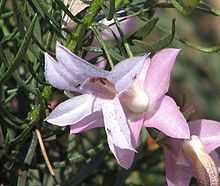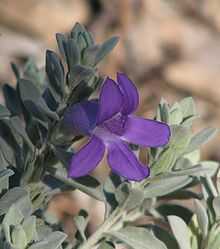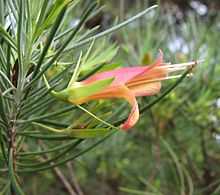Eremophila (plant)
| Eremophila | |
|---|---|
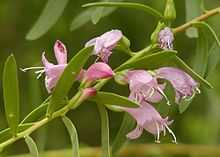 | |
| Eremophila maculata | |
| Scientific classification | |
| Kingdom: | Plantae |
| (unranked): | Angiosperms |
| (unranked): | Eudicots |
| (unranked): | Asterids |
| Order: | Lamiales |
| Family: | Scrophulariaceae[1] |
| Tribe: | Myoporeae[1] |
| Genus: | Eremophila R.Br. |
| Species | |
|
See text. | |
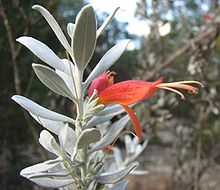
Eremophila is a genus of plants of the family Scrophulariaceae.[1] Species may be known by the common names emu bush, poverty bush, and fuchsia bush. Currently, there are about 215 recognised species, all of which are endemic to Australia. One species, Eremophila debilis, occurs in New Zealand, but it is thought to be naturalised there.[2]
Description
The size and habit of Eremophila species varies greatly, but they can be readily identified by their flowers, which have corollas with two upper lobes and three lower lobes. As the flower ages, the corolla falls off and the calyx enlarges and becomes coloured as the fruit enlarges.[3]
Species
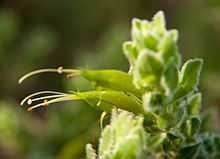
Species include:
- Eremophila abietina - spotted poverty bush
- Eremophila alternifolia - poverty bush
- Eremophila bignoniiflora - bignonia emu bush
- Eremophila bowmanii - silver turkeybush
- Eremophila brevifolia - spotted eremophila
- Eremophila debilis - winter apple
- Eremophila clarkei - turpentine bush
- Eremophila cuneifolia - pinyuru
- Eremophila debilis - winter apple, amulla
- Eremophila decipiens - slender fuchsia
- Eremophila delisseri - frontage poverty bush
- Eremophila deserti
- Eremophila dichroantha - bale-hook eremophila
- Eremophila denticulata- toothed poverty bush
- Eremophila divaricata - spreading emu bush
- Eremophila duttonii - budda, harlequin fuchsia bush
- Eremophila eriocalyx - desert pride
- Eremophila fraseri - burra
- Eremophila freelingii - limestone fuchsia, rock fuchsia bush
- Eremophila gibbifolia - coccid emu bush
- Eremophila glabra - tar bush
- Eremophila hughesii
- Eremophila hygrophana
- Eremophila lactea - milky emu bush
- Eremophila laanii
- Eremophila latrobei - crimson turkey bush
- Eremophila longifolia - berrigan
- Eremophila macdonnellii - MacDonnell's desert fuchsia
- Eremophila mackinlayi - Desert Pride
- Eremophila maculata - spotted emu bush
- Eremophila maitlandii - Shark Bay poverty bush
- Eremophila miniata - Kopi poverty bush
- Eremophila mitchellii - false sandalwood
- Eremophila nivea - silky eremophila
- Eremophila oldfieldii - pixie bush
- Eremophila oppositifolia - weeooka
- Eremophila psilocalyx
- Eremophila racemosa - showy eremophila
- Eremophila scaberula - rough emu bush
- Eremophila scoparia - silver emu bush
- Eremophila subfloccoa - dense-felted eremophila
- Eremophila subteretifolia
- Eremophila weldii
- Eremophila youngii[4]
Taxonomy
The genus was first formally described in 1810 by the botanist Robert Brown in Prodromus Florae Novae Hollandiae.[4] Eremophila is derived from the Greek words eremos (desert) and phileo (love), alluding to the species' adaptation to arid environments.[5]
Ecology
Eremophila includes entomophilous species, with flowers adapted to attract insects, and ornithophilous species, with flowers that attract birds. Entomophilous flowers have protruding lower lips, which provide a landing area for insects, and they are often blue, purple, or white. Bird-adapted flowers are red, orange, yellow, or green, and have lobes pointing downwards to discourage insects. They also tend to have longer stamens, which brush pollen on birds' heads as they feed.[3]
The fruits are eaten by emus, which disperse the seeds in their droppings.[3]
Distribution
The genus is distributed across Australia, primarily in arid regions, with the most species occurring in Western Australia.
References
- ↑ 1.0 1.1 1.2 "Genus: Eremophila R. Br.". Germplasm Resources Information Network (GRIN). United States Department of Agriculture, Agricultural Research Service, Beltsville Area.
- ↑ Chinnock, R. J. (2007). Eremophila and Allied Genera: A Monograph of the Plant Family. Rosenberg Publishing. ISBN 1-877058-16-5.
- ↑ 3.0 3.1 3.2 Moore, P. (2005). Plants of Inland Australia. Reed New Holland. ISBN 187633486X.
- ↑ 4.0 4.1 "Eremophila R.Br.". Australian Plant Name Index (APNI), IBIS database. Centre for Plant Biodiversity Research, Australian Government.
- ↑ Eremophila alternifolia. Australian Native Plants Society (Australia)
External links
![]() Media related to Eremophila at Wikimedia Commons
Media related to Eremophila at Wikimedia Commons
- "Eremophila". FloraBase. Department of Environment and Conservation, Government of Western Australia.
- "Eremophila". Electronic Flora of South Australia Fact Sheet. State Herbarium of South Australia.
